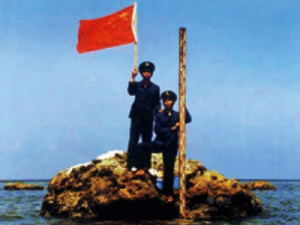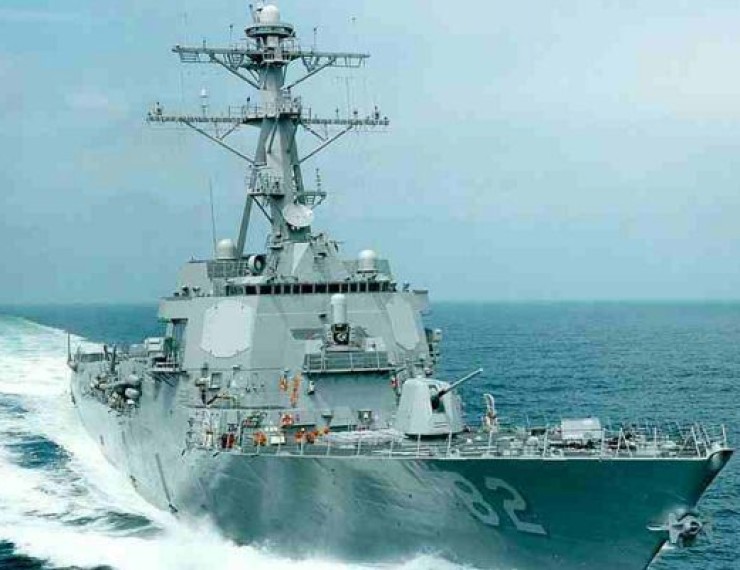The U.S. Navy this week flexed its muscles in a challenge to China’s efforts to claim most of the South China Sea as sovereign territorial waters. The guided-missile destroyer USS Lassen on Tuesday breached the 12-nautical mile zone China claims around the Subi and Mischief reefs in the Spratly archipelago, sparking bellicose reactions from Chinese officials who warned of various responses to the “deliberately provocative actions.” Among the reactions was a statement from China’s defense ministry that China will take “all necessary” measures to respond to any further U.S. Navy incursions into what it considers its territorial waters. The U.S. ambassador to China was also “summoned” to the Chinese foreign ministry so that it could officially protest the U.S. incursion.
 Well, China has drawn a line in the sand on a half-sunken reef on the other side of the world and daring America to cross it. It’s kind of like watching two kids in the schoolyard squaring off for a fight over who gets to play in the sandbox. Unfortunately, history has shown that wars have been started over less. And, unfortunately, both sides in this scrap are acting like kids in the schoolyard, with neither having a proverbial leg to stand on.
Well, China has drawn a line in the sand on a half-sunken reef on the other side of the world and daring America to cross it. It’s kind of like watching two kids in the schoolyard squaring off for a fight over who gets to play in the sandbox. Unfortunately, history has shown that wars have been started over less. And, unfortunately, both sides in this scrap are acting like kids in the schoolyard, with neither having a proverbial leg to stand on.
China’s claim to the islands (let alone most of the South China Sea) is ludicrous at best. For starters, the islands lie more than 1,000 miles away from mainland China, and are also claimed by nearby and adjacent nations such as Vietnam, Malaysia and the Philippines. Secondly, theses islands–coral reefs, actually–are pretty much underwater half the time, which means they’re officially not islands. To get around this problem, China has been engaged in a massive dredging operation since 2013 to turn the reefs into actual islands, and to date has reclaimed about 2,900 acres from the sea.
However, the United Nations Convention on the Law of the Sea clearly states: “Artificial islands, installations and structures do not possess the status of islands. They have no territorial sea of their own, and their presence does not affect the delimitation of the territorial sea, the exclusive economic zone or the continental shelf.”
Thus, the U.S. Navy drive-by, which was conducted under the “U.S. Freedom of Navigation” program to challenge what is deemed to be “excessive claims” to the world’s oceans and airspace. This U.S. program was developed to promote international adherence to the above mentioned U.N. convention.
Funny, though, the U.S. is one of the few countries in the world that is not a signatory to that U.N convention. China, though, is a signatory nation. So, on the one hand you’ve got a country trying to enforce a treaty that it’s not even a member of, and on the other you’ve got a treaty member breaking its own rules. Which one is standing on the higher ground?
We’d lean toward the U.S. on that question (feel free to Hash-it-Out!), but to complicate this whole issue further are those dreaded “political considerations.” In fact, according to Pentagon officials, the White House and U.S. State Department have been waffling over the issue for months, if not years. While the Pentagon has been long ready to carry out the sail-by operations and urging White House approval, the president has reportedly been leery of antagonizing China.
And according to some analysts, this delay in challenging China’s mis-claimed sovereignty  has only served to make the issue a bigger deal than it should be. Such a move should have been done as soon as China started asserting sovereignty as a matter of “routine,” according to the analysts. The delay only served to focus more international attention on the matter, which in turn is forcing China to maintain a steely resolve as a means of saving face.
has only served to make the issue a bigger deal than it should be. Such a move should have been done as soon as China started asserting sovereignty as a matter of “routine,” according to the analysts. The delay only served to focus more international attention on the matter, which in turn is forcing China to maintain a steely resolve as a means of saving face.
The question now is will Obama continue to exert freedom of the seas, and, if the U.S. Navy continues to do so, how will China respond? Hash-It-Out!
–M.J. Moye





